by News Section | Feb 22, 2018 | Portrait Artists, The Tradition of Portrait Painting
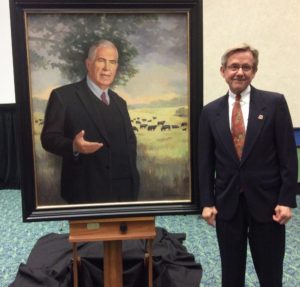 In addition to portraying cardinals, governors, prominent lawyers and doctors, and philanthropists, over the years Richard Halstead has created 23 paintings of the leaders of the American livestock industry. With Halstead paintings in the collections of the National Portrait Gallery, state capitols and universities, Richard’s paintings are also part of an unusual special collection. Legendary breeders of beef cattle in Scotland in the late 18th century, outstanding early and modern educators in animal husbandry, and current leaders in livestock production have been honored by their induction into the collection of portraits of the nationwide Saddle & Sirloin Club.
In addition to portraying cardinals, governors, prominent lawyers and doctors, and philanthropists, over the years Richard Halstead has created 23 paintings of the leaders of the American livestock industry. With Halstead paintings in the collections of the National Portrait Gallery, state capitols and universities, Richard’s paintings are also part of an unusual special collection. Legendary breeders of beef cattle in Scotland in the late 18th century, outstanding early and modern educators in animal husbandry, and current leaders in livestock production have been honored by their induction into the collection of portraits of the nationwide Saddle & Sirloin Club.
Believed to be the world’s largest portrait gallery commemorating a single industry, the portrait collection was established at Chicago’s Union Stock Yards in 1903 and is a somewhat unexpected example of the tradition of portrait painting providing a compelling visual component of the history of livestock development, especially in the Americas.
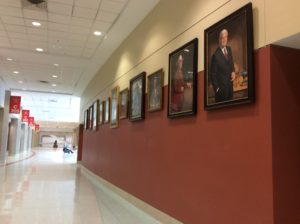 Each year a leader who has made a major contribution to the industry is selected for this award. In 2017 Angus beef cattle leader Tom Burke was honored and Richard completed his portrait for its unveiling in conjunction with the North American International Livestock Exhibition in Louisville, KY, in November 2017.
Each year a leader who has made a major contribution to the industry is selected for this award. In 2017 Angus beef cattle leader Tom Burke was honored and Richard completed his portrait for its unveiling in conjunction with the North American International Livestock Exhibition in Louisville, KY, in November 2017.
The Kentucky Exposition Center houses the entire collection and some of the most recent portraits by Richard are on permanent display.
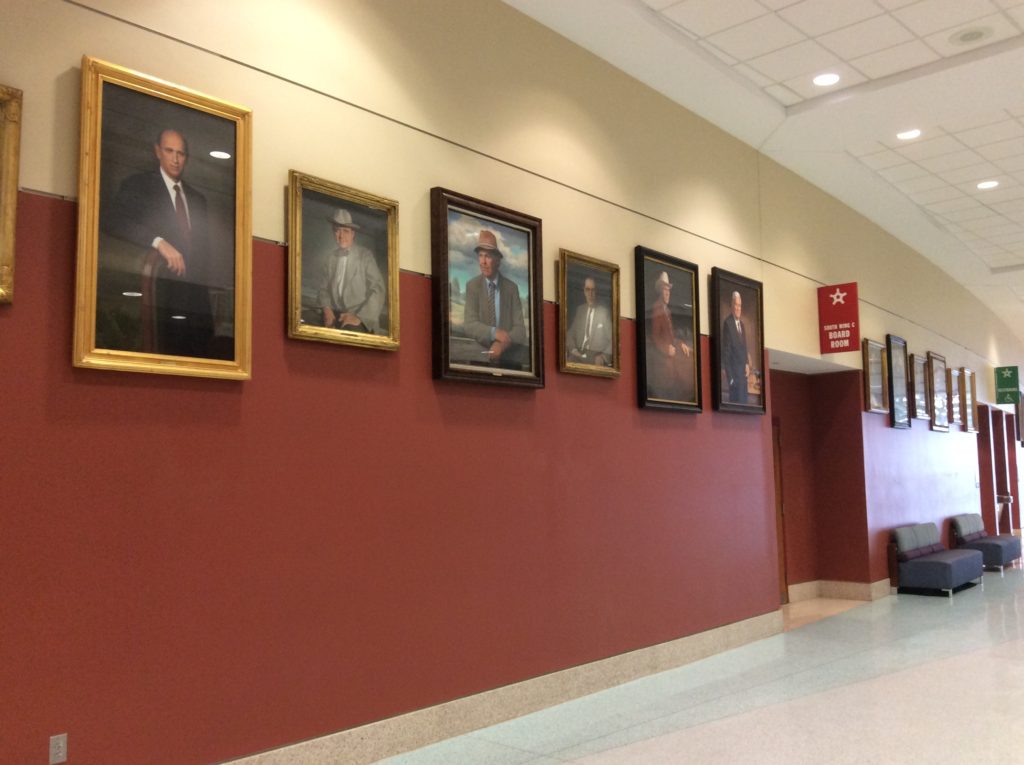
by Richard Halstead | Sep 3, 2015 | Artists' Struggles, Portrait Artists, The Tradition of Portrait Painting, Uncategorized
When I look at Ellen Eagle’s work I am reminded of my earliest interest in portraits. I was a boy, looking at reproductions of old masters’ paintings in my parents’ attic, moved by something immediately present about them but other world at the same time. Eagle’s works are like that. They are very specific to the individual sitter’s character and momentary presence, but larger yet— universal and timeless.
The famous teacher, Robert Henri once wrote: “There are moments in our lives, there are moments in a day, when we seem to see beyond the usual- become clairvoyant. We reach then into reality. Such are the moments of our greatest happiness. Such are the moments of our greatest wisdom. It is in the nature of all people to have these experiences; but in our time and under the conditions of our lives, it is only a rare few who are able to continue in the experience and find expression for it.” The Art Spirit
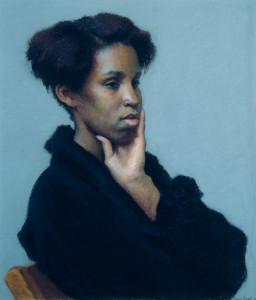
Andrea
14″ x 12-1/4″, Pastel
Eagle’s portraits are very different from Henri’s, but ironically they are the quintessence of that statement. They are so utterly real, so painfully everyday, and yet they are bathed in an ambient light that suggests her subjects are somehow blessed by an unseen presence.
I am drawn back to Eagle’s paintings whenever I grow tired of the affectations of so many contemporary portraitists. I am at first restored or refreshed by the honesty of her portrayals. Then as I study them more closely I find that little firings are going off in my brain that I can only describe as an experience of being repeatedly stunned by what she has accomplished within that quiet, unassuming presentation. Each small section is a new surprise with its own impact, yet each is perfectly integrated, so that a viewer can comfortably explore the face or figure without feeling lost or disconnected from the whole. Who would guess that there could be such subtly interwoven passages in the depiction of a single figure?
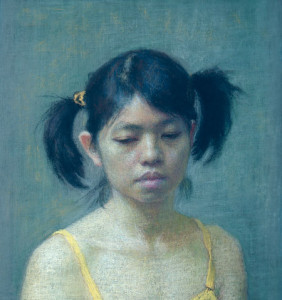
Mei-Chiao
6-1/2″ x 6-1/4″, Pastel
The people in her works, as well as her technique, are unashamedly earthy and plain but painted with the sensitivity and intricacy of a Chopin sonata. This intrinsic contrast is the basis of her power: contrast between that which is weighty and elemental, and that which is sensitive and refined; contrast between deeply felt emotion, even passion, and the restraint of discipline and thoughtfulness; contrast between the simplicity of a single figure and the complex arrangement of subtle movements within the figure and within the light and space that surrounds it. These contrasts fittingly engender both a sense of serenity and of being very much alive.

Maurice
8-1/8″ x 5-3/8″, Pastel
If you are put off by the homeliness of everyday life, you may not like her work. But if you are not, Eagle’s paintings will lead you to an even greater belief, than you may already have, in the survival of the human spirit. Her work gives us faith in that. Some of us, at various points in our lives, have questioned our ability to survive with our authentic vision intact. Eagle’s paintings suggest that she too has struggled, possibly stumbling and doubting herself now and then, but that she has tenaciously returned to that steady gaze at life as it is—-in all its quiet glory. Her works give the impression that they were made by an artist with heart, stubbornness, and conviction.
If any of you have seen her paintings and not had this feeling, I suggest that you visit them again sometime when you have a quieter mind. They require patience and receptivity. Eagle’s vision will not leap out at you. It is too dignified and worldly wise to demand your attention. It is not advertisement for the artist but rather an intimate conversation with a close friend. If you take the time to study her portraits you discover that you are in a privileged space, talking about the deepest experiences of your life, or hers or that of the subject of the portrait.
The Canadian author, Margaret Laurence was once quoted as saying that she wrote about what everyone knew but never thought to write about. In a similar way Ellen Eagle paints what we all see and typically disregard as insignificant. Tactfully and unobtrusively she slips around the shields that her sitters wear to protect them from the world and paints them in the safety of her world. By allowing us to see them in this way, in their least guarded moments, she confirms for us that what is genuine is ultimately the most beautiful.
by Richard Halstead | Feb 6, 2015 | Portrait Artists, The Tradition of Portrait Painting
To this day, many on the Eastern Seaboard consider the commissioning of painted portraits to be simply a matter of tradition and culture. Inherited from Europe and Britain during colonial times, portraits were, for over a century, their most common means of indicating a person’s status and place in history. And now, even with the technology that is available for creating immediate imagery, the painted portrait on the East Coast continues to be a symbol of distinction.
Chicago, on the other hand, was founded as recently as 1833, less than thirty years before the Civil War (1861–1865). Although the Civil War stimulated the city’s growth and economy, it stunted its cultural development. Then, only seven years after the end of the war, Chicago was devastated by fire and had to completely rebuild itself, delaying its cultural development even further. By that time, photography had become an art form in its own right and a reasonably efficient way of documenting a person’s physical character. Efficiency was a key word for the fast-growing new city. Portrait painting, to the Midwesterner’s pragmatic, bottom-line view of life and business, was an inefficient, nonessential item—even for luxurious living. Consequently, today the second largest city in the United States and a national hub of business can only lay claim to a scattering of early portraits and, in general, those are of a mediocre quality. Furthermore, Chicago’s social and financial elite have not typically thought of portraits as being a connection to their ancestors or to their progeny and future generations.
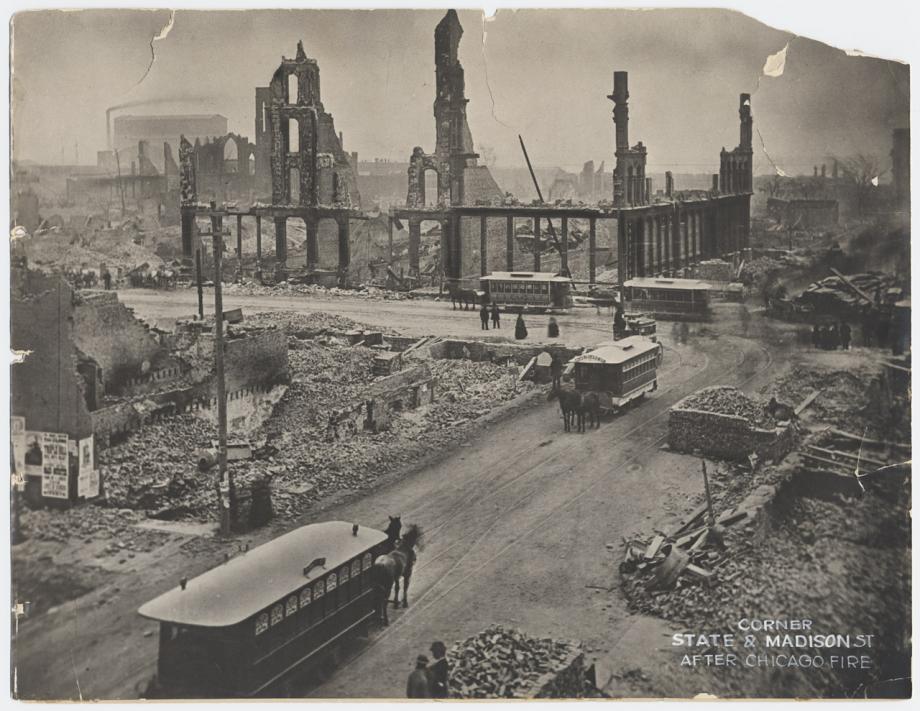
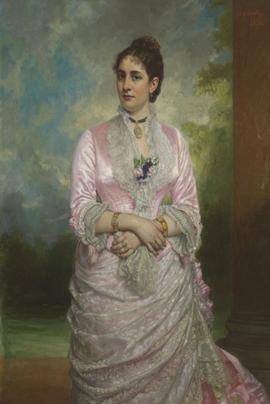
Dalia Caton Field, oil painting by George Peter Healy
There have been some exceptions, however. One of the earliest portrait artists of real quality to live and work in Chicago was George Peter Healy. Originally from Boston, Healy was classically trained in Paris by two of the most celebrated artists of that time, Thomas Couture and Antoine-Jean Gros. He became so admired as an artist in France that he was commissioned to paint King Louis Philippe. Following that the King then commissioned him to paint portraits of the most important leaders in the United States, which brought him back to his native country. That led to a long succession of solid, insightful portraits of many of America’s presidents, statesmen, business leaders, and contributors to the country’s arts and letters.
Healy came to Chicago in 1855 and painted portraits of Illinois’ most influential figures until he left in 1869. He was in Springfield to paint Abraham Lincoln shortly after Lincoln had won the the Republican Party’s presidential nomination. Healy found Lincoln to be an especially entertaining, convivial sitter, laughing at his own stories and making the time pass rapidly. At one point during the sittings Lincoln was going through some letters and he began to laugh. He read to Healy the letter, which was from a young girl who wrote that he would look better and would have a better chance at winning the presidency if he were to grow a beard. Lincoln asked Healy if he would like to paint him with a beard, to which Healy responded, “No.” The resulting portrait in fact presents the future president in a way that is very different from the iconic, bearded image that we now associate with him. It is more youthful, more open, and, I think, more revealing of the essential person than we see in any of the other portraits of him before or after that.

Presidential hopeful, Abraham Lincoln, by George Peter Alexander Healy
After the Civil War, while Healy was again in Europe, Congress commissioned him to paint a posthumous portrait of Lincoln. The figure was based on a painting Healy had previously made of Lincoln conferring with Generals Sherman and Grant and Admiral Porter. In the portrait Lincoln is represented in a thoughtful, attentive pose, leaning forward with his bearded chin resting against his hand. With this painting, Healy finally had an opportunity to paint the president as Lincoln’s young admirer had suggested.
In 1892, after more than two decades of painting continuously in Europe, Healy returned to Chicago—quite possibly to contribute to the Columbian World Exposition—and died in Chicago a few years later.
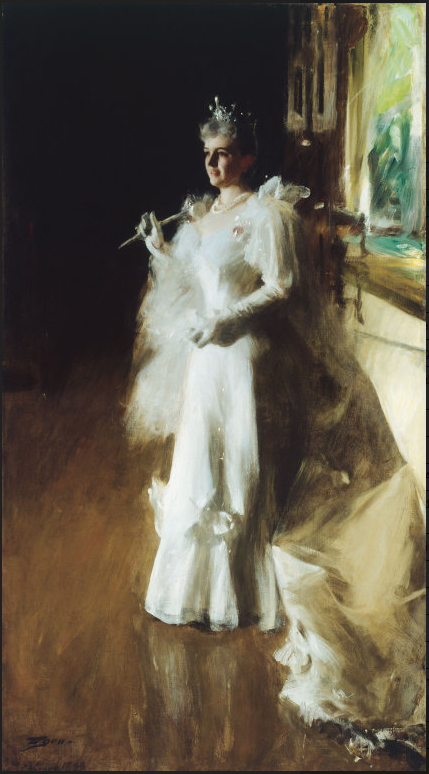
Mrs. Potter Palmer, 1893, oil painting by Anders Zorn
One of the greatest “direct,” bravura style painters of all time, Anders Zorn, came to Chicago to participate in the Exposition in 1893 and immediately took a liking to the city and its people. Despite his immense talent, international acclaim, and his marriage to a wealthy society woman, Zorn had received a rather haughty reception from the upper classes in Europe. According to Zorn, they behaved with “ceremonious style and artificial customs” that he never felt comfortable with (from “Saint-Gaudens, Zorn and the Goddesslike Miss Anderson” by William E. Hagans). Chicagoans, on the other hand, responded more to the quality of his work and character than to his pedigree, which was of a Swedish peasant stock. The simple, warm welcome Zorn received from Chicagoans was heartening to him and was confirmation of what he had come to feel in general about Americans. According to biographer William E. Hagans, Zorn wrote the following in his memoir: “Over there [in America], when they say ‘He’s all-right,’ all doors open to the foreigner, which Europeans cannot understand. Openness, honesty, straightforwardness, punctuality, these things are included in the testimonial ‘He’s all-right.’”
Naturally then, Zorn stayed in Chicago for a while. During his stay, he painted some outstanding portraits of Chicago’s industrial, commercial, and political leaders, such as Charles Deering (in the collection of the University Club), son of the founder and CEO of International Harvester, and department store magnate Potter Palmer and his wife. He also painted the chief architect of the Exposition, Daniel Burnham, and two U.S. senators from Illinois.
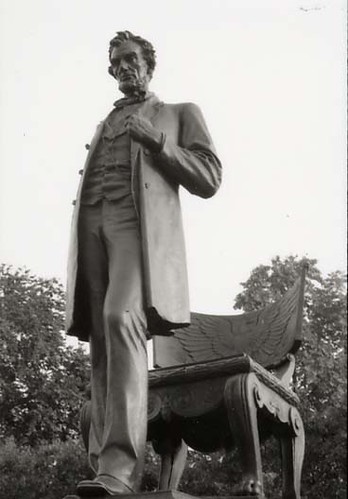
President Abraham Lincoln by Augustus Saint-Gaudens
The sculptor Augustus Saint-Gaudens, who was a friend of Zorn’s and also came to Chicago because of the Exposition, left some truly great portrait sculptures here as well. His full-figure sculptural portrait of Lincoln in Lincoln Park is one of his most impressive pieces and certainly one of the finest and the strongest, symbolic portrayals of President Lincoln and the principals he now represents.
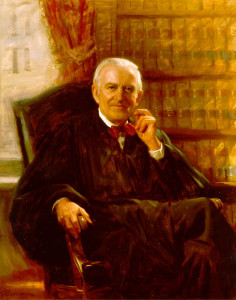
Justice John Paul Stevens, U.S. Supreme Court, by Jim Ingwerson
Since the 1960s, James Ingwerson has been the most prominent of all the Chicago portrait painters. There have been other portraitists of quality, but during his long career, Ingwerson has consistently stood at the summit.
Ingwerson’s quiet, unassuming manner belies the solidity and confidence that can be seen in his paintings. Looking at one of Ingwerson’s portraits, one is immediately struck by the perfect balance between the painting’s quality and the quality of the person portrayed. They are painted with a skill and a grace of execution that seems effortless, yet above all else there is great dignity in his creative expression, reflecting the character of the artist as well as that of his subjects.
In addition to subjects across the country, Ingwerson has painted many of the most influential Chicagoans of the past half century, and I am convinced that his portrayals of them will survive far beyond anyone’s memories of the people, just as Healy’s and Zorn’s will.
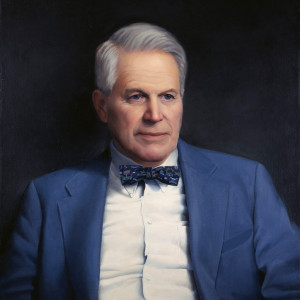
John Baird, CEO and Chairman, Baird & Warner, by Richard Halstead
Realism in general has had a difficult time reestablishing its acceptance in Chicago, however. After the 1940s, Chicago’s elite,feeling somewhat provincial in comparison with their eastern cousins, embraced the latest and often iconoclastic fashions in art. Not until recent years have tastes here become more eclectic and, as a result, have traditional art and portrait painting been given a fresh evaluation. Now, at long last, painted portraits are not competing with photography as they did in the past but, instead, generally live side-by-side as separate entities. There also seems to be an easier relationship between the traditional and contemporary arts, the two sometimes mixing in the same environment.
I believe we, here in Chicago, are about to enter an interesting period for portrait art. I sense that it is reemerging as a new tradition—not as an imitation of a past tradition or as an appropriation of other cultures’ customs, nor even as a self-conscious reaction to either of those. I believe a new tradition for portrait painting is emerging as something fresh, original, and distinctly ours, a tradition that specifically represents the values and life today in Chicago and the Midwest.
by Laura | Jul 9, 2014 | Portrait Artists, The Tradition of Portrait Painting
July/August 2014 Fine Arts Connoisseur
If you enjoyed Richard Halstead’s blog post about John Singer Sargent, you will want to pick up a copy of the 2014 July/August issue of Fine Art Connoisseur magazine, which reprises his post as an article titled “The Musicality of John Singer Sargent.” And, once you own the issue, I predict you’ll want to display it in the room where you do most of your relaxing and entertaining. That way you can easily pick it up to reread Richard’s insights and review the gorgeous Sargent paintings reprinted to illustrate his points. You’ll also have it easily on hand to share with fellow artists and art lovers.
—Laura Allen-Simpson
by Richard | Sep 3, 2013 | Portrait Artists

The Wyndham Sisters by John Singer Sargent
Considering how many books and articles have been devoted to John Singer Sargent’s life and paintings, there is surprisingly little written that attempts to explain the phenomenon of his paintings. Even artists who emulate his style generally see them as the works of a transcendent mind that can never be understood through analyses. For many of the students and followers of Sargent, the spontaneity within his paintings is the essence of that transcendent mind. Consequently, the principle they tend to apply when viewing his work, or in making their own paintings, is “Don’t think too much.”
He did fill his paintings with spontaneous passages, as a jazz musician might, and after a brief time early in his career it seems that he went directly into his paintings without any significant compositional studies. Nevertheless, there is a conscious mind behind those flashes of genius, judging, selecting and organizing them into a cohesive whole. Sargent was said to have frequently scraped down, rubbed out and reworked various areas to get the effects that he wanted. The combination of letting things fall as they may and of reconsidering or editing from those moments is what made his paintings great works of art.
Sargent had a special advantage over other artists in that he could think at an extraordinary speed. That may seem like an insignificant detail, but in a direct painting style an artist has to make important decisions within the limited time he has before the paint dries, just as a musician’s mind has to work at the speed or tempo of the piece he is performing. Sargent had a quick and agile mind, and one that could think throughout that drying time toward a final and complete orchestration.
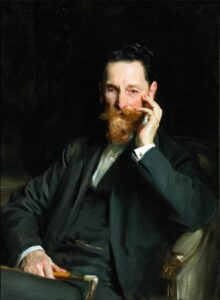
Portrait of Joseph Pulitzer by John Singer Sargent
To have a basic understanding of Sargent’s creative process, a person needs to consider what Sargent was not. He was not an artist consumed with interest in the subject’s character, so he was not distracted by it. While he was painting a portrait of the publisher Joseph Pulitzer, he actually stated that he was not interested in character, saying, “Sometimes I get a good likeness—so much the better for both of us. Sometimes I don’t—so much the worse for the subject, but I make no attempt to represent anything but what the outward appearance of a man or woman indicates.”
He was more interested in the ballet of the figures moving about in the illusionary worlds he created on canvases and in the visual music of his compositions and brushwork. Essentially, he was consumed by the creation of beauty, and he seems to have had no need to “say” anything beyond that. His clients must have sensed this fact even if they didn’t understand it. In their day, his portraits were recognized as elegantly modern images in which people wanted their likenesses placed, even if that likeness was vague.
I believe the best way to understand Sargent’s work is to see in his paintings parallels to music. Music is a timeline form of art (art that moves in time) in which the lyrics, if they are used, are carried by the rhythm, melody and spacing of time within it. Painting is a static form of art, but we view it in a timeline manner, according to where and in what priority our attention lands in different parts of the composition and pictorial space. In a good painting, our attention is guided by principles very much like the rhythm, melody and spacing in music. All representational or realistic paintings, if they are successful, are carried by these elements, described generally as design or composition, or as an underlying abstraction.
The realism in these paintings can be equated to the lyrics in a song in that both refer to ideas (often described as programmatic in music). In representational art, as in music with lyrics, there is always a balance between a reference to ideas, or meaning, and the composition or design that carries that meaning. Generally, however, one side of the equation is more dominant than the other.
In Sargent’s paintings, the realism is of an extremely high order, but the design (the shapes, texture, color, brushwork, form, and movement) predominates in the way it carries that realism. Music lovers talk about being swept away by a particular piece of music and that is very much like what happens to those of us who love Sargent’s work. The abstract side of his paintings moves us with the conspicuous excitement and grace of his execution and the unique patterns of his compositions.
But even with that predominance of abstract design, the realism is strengthened by it because it contributes largely to the feeling of life and liveliness of the figures. Sargent’s paintings are grounded in traditional realism, as dancers in a performance are grounded by the stage beneath them, reminding us that they are real people. Sargent’s paintings are firmly planted in the here and now, but the beauty of his performance, as with ballet or opera, is what moves us and elevates us out of the stresses of our daily routines.
So I was not surprised when I learned that Sargent was an accomplished musician as well as a painter. Percy Grainger and Gabriel Fauré, famous musicians and close friends of Sargent’s, said of him that his musical ability was as great as his painting skills. It is apparent, therefore, that either music had a profound influence on the way he painted and the way he thought about painting, or, music and painting were just two aspects of the same thing for him. I’m inclined to believe the latter.
My friend, the French-horn player Lisa Taylor, wrote to me recently describing Sargent’s paintings as having, “a richness, joy, lyricism and mastery of rapturous melodic line and harmony.” She compared them to compositions by the musical impressionists Fauré, Ravel, and Debussy and to the works of Shubert, Dvorak, Mozart, and Brahms, whose compositions she described as “sound tapestries of different textures and colors, created by composers who brought out the best of each instrument for which they composed.”
Others have compared his work to jazz greats. Gerald Lazare, an artist friend and honorary member of the Duke Ellington Society of Canada, sees parallels between Sargent’s paintings and Ellington’s compositions, which combine the improvisations of jazz with formal composition. He compares the dramatic range of extreme lights to extreme darks in Sargent’s paintings with Ellington’s way of using a range of sounds from the highest clarinet to the lowest baritone sax.

Paul Helleu Sketching with His Wife by John Singer Sargent
People often compare Sargent to the artists Velasquez and Franz Hals because of the looseness and dash of their brushstrokes. The brushwork of these great artists, each in its way, is powerful and timeless in its expression, but neither artist’s work has the flowing musical quality that exists in Sargent’s paintings. I associate him more with painters of the late Renaissance and Baroque periods in Italy, especially those in Venice, which was once known as the Republic of Music. The paintings of Veronese, for example, are composed as if they are rolling with elegant song and celebration; Guardi’s brushstrokes are like clear, decisive rings from brass and reed; Tiepolo’s paintings are grand opera at its best; and Tintoretto’s have the energy and intensity of some of the symphonic music of the Romantic period.
To see the musicality in Sargent’s paintings is to expand our experience of them and to understand ourselves better in the course of doing that. The first reaction most of us have to his work is awe. We feel a vicarious thrill in the power and assuredness of his athletic prowess as an artist. Then the music reaches us, independent of the performer and composer, and a door to pure exaltation opens to us. We become aware of that combination of classical order and pure, innocent joy. Many years ago, I saw on the back of an LP album cover a description of the Venetian composer Vivaldi that read, “Entirely serious in his joyfulness.” Could there possibly be a better tribute to the art and creative life of John Singer Sargent?
by Richard | Aug 19, 2012 | Composition, Portrait Artists
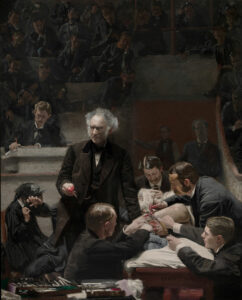
Portrait of Dr. Samuel D. Gross, Thomas Eakins
In the April 1999 issue of American Artist magazine the contemporary realist painter Jack Beal is quoted as saying about his commissioned portraits, “I tell my clients that when my portrait of them is finished, they will hate it—and their spouse will hate it even more. I capture more truth in a painting than anyone wants me to reveal, and that’s not necessarily flattering.” He also implies that his portraits’ power to disturb his clients qualifies them as museum-worthy, saying, “I warn my clients they will likely put the finished painting out of view for a while and eventually give it to a museum.”
Walt Whitman made a comparable statement about the nineteenth century artist Thomas Eakins when he said, “I never knew but one artist, and that’s Tom Eakins, who could resist the temptation to see what they thought ought to [be] rather than what is.” Eakins was like Beal in that he insisted on faithfulness to the truths before him, but beyond that the two artists are very different.
Although Eakins was ambitious to immortalize himself through his work, and was probably more concerned about his personal aesthetics than he was about people, his portraits never put his subjects beneath him. In fact his paintings often mirror and sometimes parallel the qualities of the people he painted. His portrait of the famous pioneering surgeon Dr. Samuel Gross is a remarkable example of that because it is an obvious, and I think successful, effort to put himself on equal footing with Gross—without diminishing Gross’s stature in any way.
Good composition in a portrait generally indicates an artist’s respect for his subject, or at least of what that person represents, because the solidity and grace it imparts suggests that comparable traits exist within the subject’s character. In light of that fact, the contrast between these two artists becomes even more apparent.
In the article mentioned above, “Jack Beal’s Portraits of Life,” the author Stephen Doherty emphasizes Beal’s interest in composition: “Beal frequently lectures and writes about composition, constantly urging artists to create the illusion of greater and livelier space within their pictures.” Beal’s early paintings sometimes had a rhythmic flow within the figures themselves but his later commissioned works, even within the figures, have none of that movement. Rather than creating the “lively space” he describes in his lectures, his pictures are often static, the shapes are sometimes repetitive and the compositions in general lack a prioritizing of the order in which the viewer’s attention is held. That is tantamount to not composing at all. Compare his composition in the portrait of President Olin C. Robison that hangs in the Middlebury College in Vermont with Eakins’s painting of Dr. Samuel D. Gross, painted for the Gross Clinic and now hanging in the Philadelphia Museum of Art.
[NOTE: To see Beal’s portrait, go to www.jackbeal.net/89_robison.html ; copyright prohibits us from making the image available here]
Eakins’s painting of Dr. Gross is built like a grand temple, a tribute to science and to the virtues of thought and accomplishment. It is architecturally solid and within that structure is a carefully choreographed scene. The combination of shapes and the lighting and shadows provide the same order of succession that dialogue and movement create in a masterful stage production. Eakins does not restrict our movements. Instead he gives us logical and inviting options. He allows us to travel throughout his illusionary space along any of many pathways, each one prescribed to give us the fullness of his experience of the scene. He imagines that each of us would enter the pictorial space from a different place with different initial interests and gives us the added option of changing course as our pathway crosses others, but he brings us all to the same ultimate conclusion or completion once we have absorbed the entire picture. None of the routes we might choose are boring. There is no redundancy in shapes or in emotional content. Each figure, including the patient and the students in the gallery, is playing a unique role with a different, very expressive gesture that is an integral part of the whole.
The scene Eakins created, and still creates, has stillness yet moves and has power. We feel a momentary hesitation between events, as if Dr. Gross has deliberately paused in his address to punctuate his last statement or to gain the audience’s full attention before his next point. Even the mood is a careful balance of various elements in the room.
Every small section in this pictorial space is accounted for. There is nothing extraneous. Nothing is overstated or understated. Eakins’s creation is a compositional masterpiece. It is an ideal that even he could not always live up to but which points the way for any person who aspires to create works that have lasting quality. It also should be instructive to those who, like Beal, have elitist notions about their compositional acumen when, in fact, they have taken a rather lackluster approach from start to finish.
By comparison with Eakins portrait of Dr. Gross, the realism that Beal proudly extols holds little interest for most of us, and his unwillingness to go beyond that, to add to that reality in any enriching way, makes his efforts seem empty, banal and pointless.
 In addition to portraying cardinals, governors, prominent lawyers and doctors, and philanthropists, over the years Richard Halstead has created 23 paintings of the leaders of the American livestock industry. With Halstead paintings in the collections of the National Portrait Gallery, state capitols and universities, Richard’s paintings are also part of an unusual special collection. Legendary breeders of beef cattle in Scotland in the late 18th century, outstanding early and modern educators in animal husbandry, and current leaders in livestock production have been honored by their induction into the collection of portraits of the nationwide Saddle & Sirloin Club.
In addition to portraying cardinals, governors, prominent lawyers and doctors, and philanthropists, over the years Richard Halstead has created 23 paintings of the leaders of the American livestock industry. With Halstead paintings in the collections of the National Portrait Gallery, state capitols and universities, Richard’s paintings are also part of an unusual special collection. Legendary breeders of beef cattle in Scotland in the late 18th century, outstanding early and modern educators in animal husbandry, and current leaders in livestock production have been honored by their induction into the collection of portraits of the nationwide Saddle & Sirloin Club. Each year a leader who has made a major contribution to the industry is selected for this award. In 2017 Angus beef cattle leader Tom Burke was honored and Richard completed his portrait for its unveiling in conjunction with the North American International Livestock Exhibition in Louisville, KY, in November 2017.
Each year a leader who has made a major contribution to the industry is selected for this award. In 2017 Angus beef cattle leader Tom Burke was honored and Richard completed his portrait for its unveiling in conjunction with the North American International Livestock Exhibition in Louisville, KY, in November 2017.














